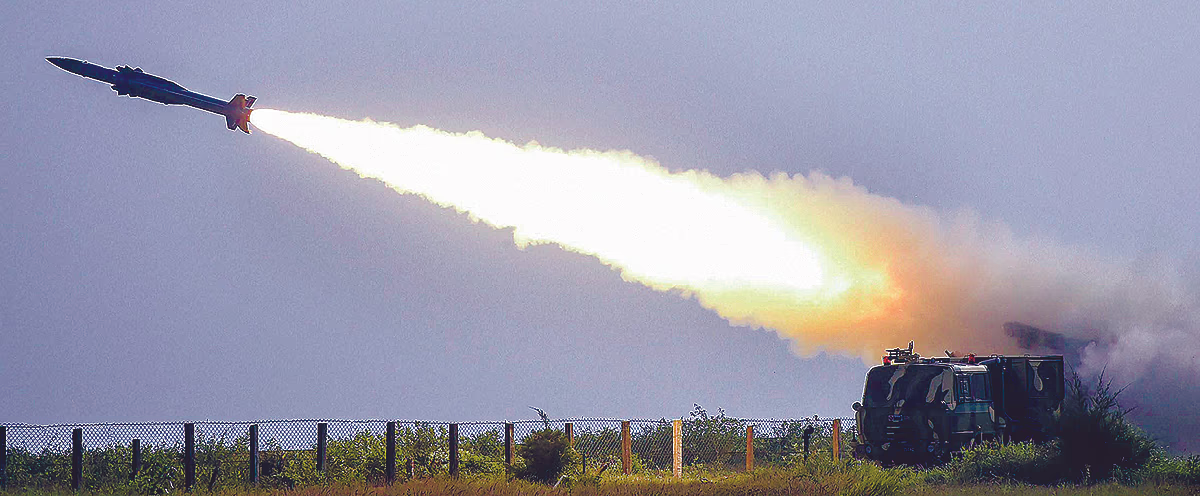On May 10, 2025, tensions peaked between India and Pakistan when Pakistan launched attacks using drones, missiles, and fighter jets across 26 locations from Srinagar to Naliya. This offensive involved weapons such as Fateh-1 missiles, JF-17, F-16, and DJI military drones. India's Akash Air Defense System intercepted and neutralized these aerial threats effectively, completely foiling the Pakistani assault.
Akash Air Defense System
The Akash is India's indigenously developed medium-range surface-to-air missile system, crafted by the Defence Research and Development Organisation (DRDO). It has been operational in the Indian Army and Air Force since 2014. The advanced version, Akash-NG (Next Generation), was inducted in 2021. This system is adept at eliminating airborne threats at low and medium altitudes, such as fighter jets, drones, and cruise missiles.
Read More:
Features
Range: 45-70 km (Akash-NG)
Targets: Fighter jets, drones, cruise missiles, and ballistic missiles
Guidance: Radar-based command guidance and active radar homing (Akash-NG)
Warhead: 60 kg high-explosive
Accuracy: 90-100% interception rate
Deployment: Mobile launchers on tanks and trucks for excellent mobility.
Electronic Counter-Countermeasures (ECCM): Capable of overcoming enemy jamming and electronic interference.
Indigenization: More than 96% localized components, embodying the 'Make in India' initiative.
Last year, the Akash missile successfully obliterated four targets. This achievement positioned India as the world's first nation to demolish four aerial targets with a single missile unit. Each unit of the Akash Missile System is equipped with four missiles capable of destroying distinct targets.
Read More:

Source: aajtak
Thwarting Pakistani Attacks
The aerial strikes by Pakistan from May 7-10, 2025, were a counteraction to Operation Sindoor, which saw India annihilate nine terrorist bases in PoK and Pakistan on May 7. This operation was a retaliation against the April 22 terror attack in Pahalgam.
May 7-8:
Drone and missile attacks on 15 cities (Srinagar, Jammu, Pathankot, Amritsar, Chandigarh, etc.).
May 9:
At 1:40 AM, Punjab's airbase was struck by a Fateh-1 missile.
May 10:
From Srinagar to Naliya, 26 sites (Baramulla, Avantipura, Jammu, Ferozepur, Jaisalmer, Bhuj, etc.) were targeted by JF-17, F-16, J-10, PL-15 AAM, AMRAAM, and DJI military drones.
Read More:
Role of Akash
Defeat of Fateh-1:
On May 9, the Akash-NG intercepted and destroyed the Fateh-1 missile launched at Punjab mid-air. As soon as the missile entered Akash's 70 km range, it was tracked and neutralized.
JF-17 and F-16:
On May 10, Akash systems positioned in Jammu and Pathankot downed a JF-17 jet, while an F-16 was also damaged.
Drone Swarms:
Akash incapacitated DJI military drones and other swarms attempting to attack Srinagar, Baramulla, and Bhuj. The ECCM capability and radar accuracy of Akash were pivotal in these efforts.
Missile Attacks:
PL-15 and AMRAAM missiles were destroyed by Akash in Punjab and Rajasthan.
Read More:

Source: aajtak
Multiple Upgrades in the Missile
The ground systems of the Akash missile have undergone significant upgrades. Additionally, radar, EOTS, and telemetry stations, along with missile trajectory and flight parameters, have seen improvements. More details have not yet been shared by the army, government, or DRDO.
Akash Missile's Three Variants
In India, there are three variants of this system: the first one is Akash MK-I with a range of 30KM, Akash MK-II with a range of 40KM, and Akash-NG with a range of 80KM. Akash-NG can eliminate enemy aircraft or missiles at altitudes of up to 20 km.
Speed: Its Greatest Strength
It travels at a speed of 2.5 Mach or 3087 km/hr. The Akash-NG, a Next-Generation Missile, is designed for surface-to-air combat. It boasts a range of 40 to 80 km and features an Active Electronically Scanned Array Multifunction Radar capable of scanning multiple enemy missiles or aircraft simultaneously.
The Akash-NG missile can be launched from a mobile platform. Weighing 720 kg, it stands 19 feet tall and spans a diameter of 1.16 feet, carrying a payload of up to 60 kg.
Last year, during a border skirmish with China, the older version of Akash-NG was deployed along the Line of Actual Control (LAC) in Ladakh. The Indian Air Force also stationed Akash missiles at bases such as Gwalior, Jalpaiguri, Tejpur, Jorhat, and Pune.




